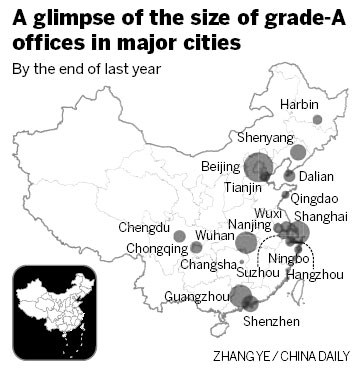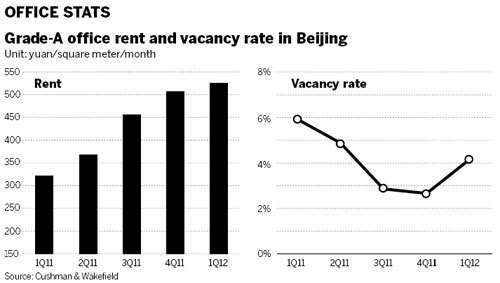

|
Growth in rents for prime offices in Beijing has gone down in comparison with last year as a result of the release of a total of 136,000 square meters of new offices in the first quarter in the market. It pushed up the overall Grade-A office vacancy rate by 1.5 percent quarter-on-quarter to 4.2 percent. The rent grew 3.6 percent quarter-on-quarter to 525 yuan ($83.30) a sq m each month, according to Cushman & Wakefield. Mai Tian / For China Daily |
Move follows rise of 75% in 2011 over 2010, the highest increase in any city in the world
Growth in rents for prime offices in both Beijing and Shanghai slowed down in the first quarter of 2012 after experiencing a skyrocketing increase last year, industry analysts said.
Beijing remained a landlord's market in the first quarter, with demand remaining active. The rent growth, however, has slowed down compared with last year, real estate consultancy firm Cushman & Wakefield China said in its latest report.
A total of 136,000 square meters of offices entered the market in the first quarter, pushing up the overall Grade-A office vacancy rate by 1.5 percent quarter-on-quarter to 4.2 percent. The rent grew 3.6 percent quarter-on-quarter to 525 yuan ($83.3) per sq m each month, according to Cushman & Wakefield.
Statistics from Cushman & Wakefield showed that the prime office rents in Beijing's central business district soared 75 percent in 2011 from the previous year, the highest increase of any city in the world.
"While lowering their expectations for the rate of rent growth, landlords have also put some reserved office space on to the market," said Zhang Ping, research director for Cushman & Wakefield.
As the Grade-A office sample of Jones Lang LaSalle differs from that of Cushman & Wakefield, JLL's statistics for the performance of Beijing's office market were a bit different, but the trend is similar. According to JLL, rents lost strong growth momentum, increasing by 4 percent quarter-on-quarter in the first three months.
Demand for office space in Beijing remained stable and saw healthy growth in the first quarter. However, leasing demand in the capital didn't experience the strong growth it showed in the first quarter of 2011, JLL said in its report.
"Factors leading to a slowdown in the growth include higher rents than ever before, more time required to find suitable space and a lower GDP growth target in the country's 12th Five-Year Plan (2011-2015)," said Qin Xiaomei, chief researcher at JLL. "All these factors weakened the abilities of some enterprises' office expansion."
According to Qin, office rents in Beijing will probably grow 18 to 20 percent this year because demand remained strong while the supply is still limited.
In Shanghai, the average Grade-A office rents remain stable. The first quarter saw the vacancy rate rise one percent quarter-on-quarter to 5.8 percent, as expensive rents and a lack of new supply drove some core submarket occupiers to opt to relocate to some sub-CBD markets, according to Cushman & Wakefield.
Although the vacancy rate of Grade-A offices in both Beijing and Shanghai remained at a low level, the rate in second-tier cities grew rapidly because of surging demand.
In Chengdu, for instance, the vacancy rate stayed at a relatively high level of 27.7 percent in the first quarter this year, up 0.9 percent from last quarter, according Cushman & Wakefield.
As a result of new supply deliveries, Guangzhou experienced an elevation in vacancy rates by 5.4 percent quarter-on-quarter to 13.1 percent. In Shenzhen, the completion of Kerry Plaza II delivered 69,000 sq m of high quality office space to the market, thus pushing the vacancy rate up by 3.2 percent, to 19 percent, the report from Cushman & Wakefield showed.
"In Beijing, the office market will return to a more rational status, with slower rental increases. As Shanghai positions itself as an international financial and shipping center, the demand will remain active with new submarkets becoming an alternative choice for corporate occupiers," said Daniel Wang, executive director of corporate investors' and occupiers' services for Cushman & Wakefield China.
"Some second-tier cities such as Chengdu and Guangzhou, however, will experience considerable pressure for absorption due to an influx of supply," he added.

For Jack Ye, national director of investment and capital markets at Cushman & Wakefield China, controls on housing are making office and retail properties appealing for investment purposes.
"We expect to see more offshore funds investing in real estate projects and also an increase in land transactions in second- and third-tier cities," said Ye.
"Offices in Beijing and Shanghai remain a hot spot for investment, while retail markets in first- and key second-tier cities are also a focus for institutional investors," he added.
In January, for instance, the Keppel Corporation, a Singapore-based developer, acquired a 51 percent stake in a composite site with three office buildings and a prime retail podium located in Beijing's CBD area.
According to a recent report by E-commercial China, commercial complexes will continue to appeal strongly to institutional investors this year.
"As the government's curbs on the residential sector continue, the commercial sites with prime locations are the focus for deals with a transaction price exceeding $10 million," said Yin Baojun, vice-president of E-commercial China.
huyuanyuan@chinadaily.com.cn

(China Daily 05/15/2012 page14)